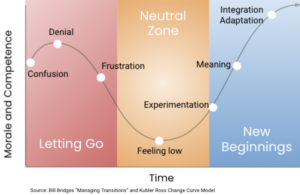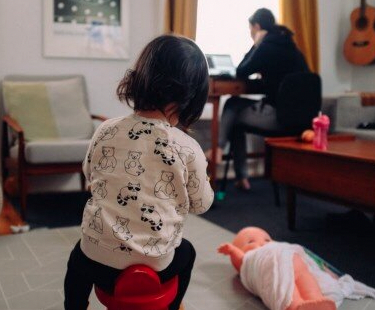In this post, I will explain how teams entering hybrid work can rebuild and redefine how they work together. By the end of this post/guide, you will have learned:
- What are cultural norms and why it’s important to be intentional about them as you enter hybrid work
- What conversations will help your team intentionally transition into hybrid work
- Some tips on having those team conversations
.png?width=1920&name=Hybrid%20Teams%20(1).png)
At Regroup we help tech teams develop psychological safety, clarity, and cohesiveness to become high-performing teams. Many of our clients are starting to transition into hybrid work and planning out the logistics. However, transitioning your team into hybrid work is more than a logistical challenge, it’s a cultural one.
As a society, we are approaching a once-in-a-generation opportunity to redefine the way we work in teams. Last year forced many teams to work from home, away from the office, and away from one another. You figured out how to work together, but it probably felt sudden and haphazard; and, for many, it resulted in team challenges like a lack of connection and clarity. Now, as offices start reopening, we have an opportunity to intentionally design a way of working that fosters thriving, high-performing teams.
As you enter hybrid work, don’t let this moment feel haphazard. Take time to be intentional about how your team will work together in this new structure.
Yes, you may have already defined the logistics, like how many days people will be in the office and who will be able to work remotely. However, you may not have addressed how you’ll use your in-person time, or how to ensure all voices are heard when eighty-percent of the team is in-person in a conference room and twenty-percent of the team is on video conference, some with their cameras off. Again, boosting your team performance will be more than about logistics (the “what”), it will also be about the cultural norms you embed as you enter hybrid work (the “how”).
What are cultural norms? Simply put, norms describe “the way we do things around here.” They are the implicit (and sometimes explicit) shared expectations of group behavior that we teach to newcomers. Think about your team over the last year:
- What were some of the norms or shared expectations for behavior in the group? Some examples:
- During Zoom meetings, did team members use the Raise Hand feature to speak up, or did they interrupt and talk over each other?
- Did team members reach out to ask each other for help when they were stuck, or did they try to figure out a problem on their own?
- Did the team respond to Slack messages late at night or over the weekend?
- Which group norms served your team well and which detracted from the work or environment?
Now, think about your team as you enter hybrid work, with some people in the office and some people working remotely, maybe with some “in-person days” and some “WFH days.”
- What cultural norms or behaviors will increase your team’s effectiveness?
- Will it help the team if team members check-in with each other, just to build relationships?
- How about if team members clarify roles and responsibilities at the beginning of a project? Or, clarify decision-making roles when you make a team decision?
- What behaviors will help hybrid meetings? Will it help the team if remote team members keep their videos on and interrupt to ask questions or share opinions?
- What norms will raise your own engagement and performance in hybrid work?
- Do you need more connection with your colleagues? Would you like them to check in with you?
- Do you want to be able to ping your colleagues for help or ask a question out of the blue?
- If you’re a remote team member, what norms might help raise your visibility in the team?
With hybrid work fast approaching, now is the time to start having conversations with your team about the team you want to become as you enter hybrid work. I’d like to share three key conversations to help you set the stage for forming a successful hybrid team, as well as a few tips to guide you in leading these discussions.
1. A retrospective on the last year
Before we can craft a new way of working together, it’s important to take time for retrospective reflection. As a team, pause and explore what you’ve learned over the last year about how you’ve worked together.
People in your team will have had different experiences and have different preferences. From our clients, we saw that many individuals struggled with working remotely: it was hard to bond with work colleagues and build social relationships; there were more meetings, which meant less focused work-time; and there were more distractions. However, we also heard about the benefits in working remotely: more flexibility with where and when you work, less commute time, (for some) a quieter workspace, and more time to bond with family and pets.
Questions to explore with your team:
- What was the last year like for you?
- What worked well over the past year in how we worked together? What habits, norms, or practices do we want to continue as we enter hybrid work?
- What didn’t work so well? What habits, norms, or behaviors should we stop as we enter hybrid work?
2. A conversation about change
The change has been announced, the policies are getting set, but your teammates will need time to fully process the change in order to hit the ground running. According to the William Bridges change model, to fully transition into the change, each individual must pass through three phases: Letting Go, Neutral Zone, and New Beginnings.
Each individual will go through these phases at their own pace and may go back and forth in the model over time. To speed things up, have a team conversation introducing this change model to build awareness and shared language. Then, explore where your teammates are on the model and how you can support each other in navigating the change.
Questions to explore with your team:
- Where are you on this change model? How are you feeling about the change?
- What support do you need to move forward?
- What are you most excited about?
- What are you most concerned about?
- What is most important to you in the transition to hybrid work?
3. An agreement about norms
As we enter hybrid work, let’s have a learning mindset about “how we do things around here.” This is a new season. No one has figured out the ‘right way’ yet, and you don’t need the right answers. You just need to adopt a learning mindset and be ready to experiment.
As a team, explore the team behaviors, the norms, that will support you and the team as you enter hybrid work. Agree on a few of these norms together, try them out, reflect on how they’re working, and then adjust accordingly.
Questions to explore with your team:
- How do you want to feel about the team in six months?
- What team norms might help you to feel that way?
- What norms should we try out for hybrid meetings?
- What’s the purpose of our in-person days and what norms would help us fulfill that purpose?
- What norms will help us communicate and collaborate effectively with each other?
As you approach these conversations be mindful that each conversation is an opportunity to co-create your team culture. Here are some tips for having productive conversations with your team:
- Arrive in the conversation with a mindset of curiosity and compassion, and an openness to learning and hearing different perspectives.
- Frame the discussion by setting the context on the purpose and goals of the conversation.
- Set some ground rules before diving into the conversation – my favorite is to listen with curiosity.
- If you’re a team with more than eight people, use breakout room functionality to have small groups discuss and then come back together to share back.
- Schedule enough time for all voices and perspectives to be heard. It will probably take longer than you think.
- In a hybrid team, we need to be curious and mindful about who has access, about where power and influence will live, and about what equity looks like for each of us.
- You won’t resolve everything in one conversation, so plan on having multiple conversations, over time.
What will you do with your once-in-a-generation opportunity to redefine how teams work together? This moment doesn’t need to feel haphazard and sudden. It can feel intentional, experimental, and supportive. I hope you take time to be intentional about how your team will work together in this new hybrid structure. You don’t need to have all the answers, you just need to have an open mind to learn and iterate together.
Are you ready to have these team conversations, but not sure where to start? Sign up to get our free team conversation guides! In the coming weeks we’ll be launching free team conversation guides to help your team through this transition into hybrid work. Don’t miss out! Sign up today to get these guides the day they drop.


-1.png)

